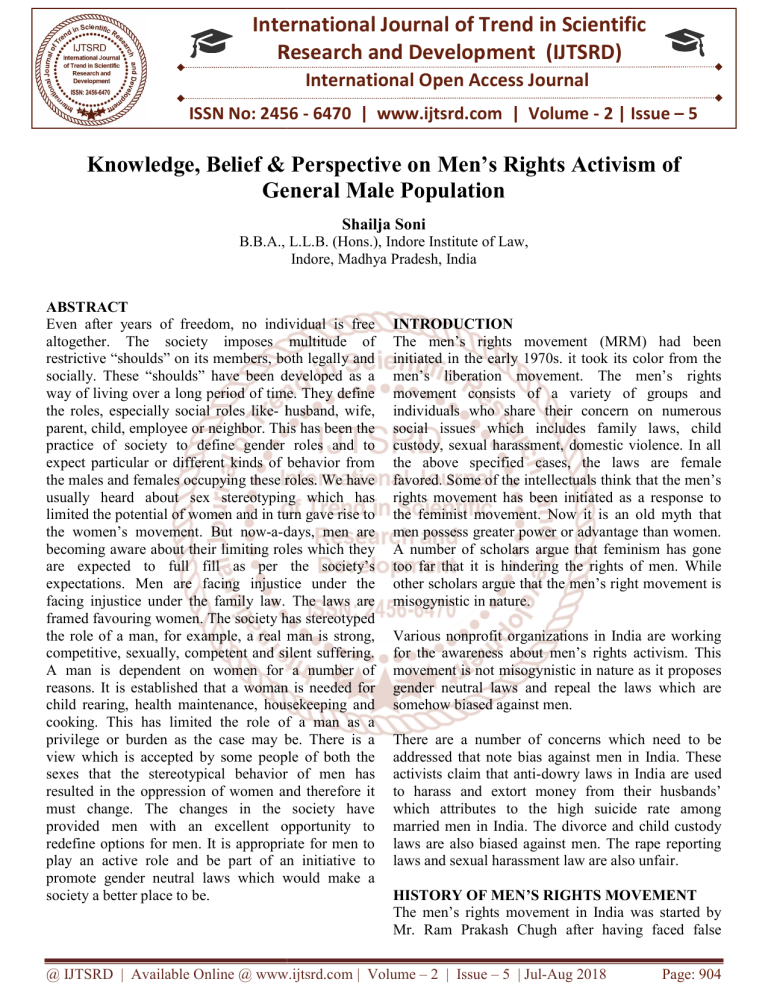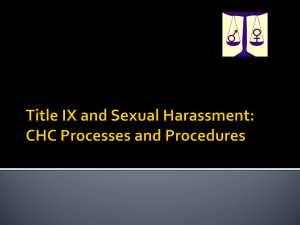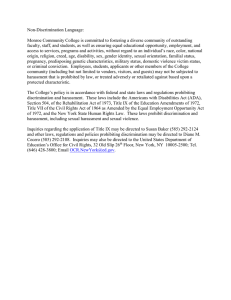
International Journal of Trend in Scientific
Research and Development (IJTSRD)
International Open Access Journal
ISSN No: 2456 - 6470 | www.ijtsrd.com | Volume - 2 | Issue – 5
Knowledge, Belief & Perspective on
n Men’s Rights Activism of
General Male Population
Shailja Soni
B.B.A., L
L.L.B. (Hons.), Indore Institute of Law,
Indore, Madhya Pradesh, India
ABSTRACT
Even after years of freedom, no individual is free
altogether. The society imposes multitude of
restrictive “shoulds” on its members, both legally and
socially. These “shoulds” have been developed as a
way of living over a long period of time. They define
the roles, especially social roles like- husband, wife,
parent, child, employee
oyee or neighbor. This has been the
practice of society to define gender roles and to
expect particular or different kinds of behavior from
the males and females occupying these roles. We have
usually heard about sex stereotyping which has
limited the potential
ntial of women and in turn gave rise to
the women’s movement. But now-a-days,
days, men are
becoming aware about their limiting roles which they
are expected to full fill as per the society’s
expectations. Men are facing injustice under the
facing injustice underr the family law. The laws are
framed favouring women. The society has stereotyped
the role of a man, for example, a real man is strong,
competitive, sexually, competent and silent suffering.
A man is dependent on women for a number of
reasons. It is established
lished that a woman is needed for
child rearing, health maintenance, housekeeping and
cooking. This has limited the role of a man as a
privilege or burden as the case may be. There is a
view which is accepted by some people of both the
sexes that the stereotypical
otypical behavior of men has
resulted in the oppression of women and therefore it
must change. The changes in the society have
provided men with an excellent opportunity to
redefine options for men. It is appropriate for men to
play an active role and be part
art of an initiative to
promote gender neutral laws which would make a
society a better place to be.
INTRODUCTION
The men’s rights movement (MRM) had been
initiated in the early 1970s. it took its color from the
men’s liberation movement. The men’s rights
movement consists of a variety of groups and
individuals who share their concern on numerous
social issues which includes family laws, child
custody, sexual harassment, domestic violence. In all
the above specified cases, the laws are female
favored.. Some of the intellectuals think that the men’s
rights movement has been initiated as a response to
the feminist movement. Now it is an old myth that
men possess greater power or advantage than women.
A number of scholars argue that feminism has gone
too far that it is hindering the rights of men. While
other scholars argue that the men’s right movement is
misogynistic in nature.
Various nonprofit organizations in India are working
for the awareness about men’s rights activism. This
movement is not misogynistic
nistic in nature as it proposes
gender neutral laws and repeal the laws which are
somehow biased against men.
There are a number of concerns which need to be
addressed that note bias against men in India. These
activists claim that anti-dowry
dowry laws in India
Indi are used
to harass and extort money from their husbands’
which attributes to the high suicide rate among
married men in India. The divorce and child custody
laws are also biased against men. The rape reporting
laws and sexual harassment law are also unfair.
unfa
HISTORY OF MEN’S RIGHTS MOVEMENT
The men’s rights movement in India was started by
Mr. Ram Prakash Chugh after having faced false
@ IJTSRD | Available Online @ www.ijtsrd.com | Volume – 2 | Issue – 5 | Jul-Aug 2018
Page: 904
International Journal of Trend in Scientific Research and Development (IJTSRD) ISSN: 2456-6470
claims of dowry harassment himself. He formed an
organization called “society for prevention of cruelty
to husbands”. A helpline named Sangyabaly was
started for husbands and families harassed by antidowry laws by Arun Murthy in Bangalore. On 19th
November 2007, International Men’s Day was
celebrated for the first time in India by “Save India
Family Foundation”, (SIFF).
CONCERNS AND DISCUSSION
1.
Anti-Dowry Laws
The anti-dowry laws are being frequently used to
harass and extort husbands. The suicide rate among
married men has also increased over the years. Dowry
was criminalized in the year 1961 under the Dowry
Prohibition Act, 1961. The most debated and popular
section i.e. Section 498A of the Indian Penal Code
was introduced in 1983.
The Section 498A of the Indian Penal Code states
that:
Whoever, being the husband or the relative of the
husband of a woman, subjects such woman to cruelty
shall be punished with imprisonment for a term which
may extend to three years and shall also be liable to
fine.
2.
Divorce and Child Custody Laws
The divorce and child custody laws are biased against
men. Men are not allowed to see their children for a
long period of time after divorce. Men’s rights
activists advocate that wife should not be granted
alimony if she is the primary earner of the family. The
law must also see men capable of bringing up
children. In India, the custody of children after
divorce is governed by two laws: Guardians and
Wards Act, 1890 and Hindu Minority and
Guardianship Act, 1956. The irony is that both these
laws do not contain provisions for shared parenting or
joint custody.
3.
Domestic Violence
The number of men who are victims of domestic
violence has increased in the recent years. But such
cases go unreported as men feel ashamed to report the
abuse. They also fear false accusations against them
in reprisal. Some groups like the Save Indian Family
Foundation (SIFF) and the Indian Social Awareness
and Activism Forum (INSAAF) have demanded
inclusion of issues faced by men in the National
Family Health Survey (NFHS) conducted by the
Ministry of Health and Family Welfare to manifest
the actual picture of the situation.
The Protection of Women from Domestic Violence
Act, 2005 provides protection to wives and female
live-in partners from domestic violence carried out by
husbands, male live-in partners or their relatives.
Swarup Sarkar of Save Family Foundation has termed
the law as legal terrorism.
4.
Rape Reporting Laws
The number of reported rape cases rose from 16,075
to 24,923 between 2001 and 2012. At the same time,
the conviction rate fell from 40.8 percent to 24.2
percent. Some men’s rights activists believe that the
low conviction rate is because of false reporting of
cases.
5.
Suicide
The Save Indian Family Foundation (SIFF) has
claimed that the suicide rate of married men is twice
as that of married men is twice as that woman because
they are unable to withstand the abuse from their
wives. It has pointed to the National Crime Records
Bureau (NCRB) data to show that the suicide rate in
married men is much higher than that in married
women. A researcher at the Save Indian Family
Foundation found out that police don’t take any action
even if the suicide note of man states that he was
tortured by his wife and in-laws, but in the case of
women the husband’s family is taken into custody
without investigation.
6.
Sexual Harassment Laws
The Sexual Harassment of Women at Workplace
(Prevention, Prohibition and Redressal) Act, 2013 is
not a gender-neutral law. The bill was originally
gender neutral until Ministry of Women and Child
Development and some NGOs intervened and
changed the name. It is an outdated concept to
consider that only women suffer from sexual
harassment.
THE STUDY AND JUSTIFICATION OF STUDY
A research was conducted by the author of this
research paper under All India Institute of Local Self
Government in the city of Indore to get the insights of
men on this issue. It was a brief review regarding
men’s rights related beliefs among the men in the
society which reveals that the statutes related to
domestic violence and sexual harassment must be
made gender neutral.
@ IJTSRD | Available Online @ www.ijtsrd.com | Volume – 2 | Issue – 5 | Jul-Aug 2018
Page: 905
International Journal of Trend in Scientific Research and Development (IJTSRD) ISSN: 2456-6470
RESEARCH METHODOLOGY
OBJECTIVES:
To define the awareness level and knowledge
about various acts (the Domestic Violence Act,
2005, the Sexual Harassment of Women at
Workplace, 2013, the Dowry Prohibition Act,
1961, the Pre-Conception and Pre-Natal
Diagnostic Techniques Act, 1994) in general.
Male population of Indore city.
To find out the perspective of male population
about having gender neutral laws.
To evaluate the respondent’s belief towards false
filing of cases by women in family matters.
HYPOTHESIS DEVELOPMENT
A hypothesis is a proposition, which the researcher
wants to verify. In this research there are some
hypotheses which are given below: There is a relationship between educational
qualification and want of gender neutral laws
related to domestic violence by the respondents.
There is a relationship between the marital status
and having witnessed male victim of domestic
violence.
RESEARCH DESIGN
As this research is under taken to know different
perspectives of male population regarding ‘Men’s
Rights’ by means of structured instrument ie.
“Questionnaire”. So, here descriptive research design
is used for research.
DATA COLLECTION TECHNIQUES
PRIMARY DATA- Through schedules as the
aim and objective of the study had to be cleared to
the respondents and remove the difficulties of any
respondent in the understanding concepts.
SECONDARY DATA- It was collected from
interest as well as journals and newspapers.
SAMPLE DESIGN AND SAMPLE SIZE
UNIVERSE: The whole urban area of Indore city
is the universe for this research.
SAMPLE SIZE: Total sample size is 100 males.
SAMPLE UNIT: Unit of analysis is a male above
18 years of age.
SAMPLE DESIGN: Stratified random sampling.
DATA COLLECTION
Having prepared the questionnaire and selected the
sample design and the size of sample, the next step is
to organize and conduct the field survey. So, we have
selected these fields for study. For data collection, we
have explored Vijay Nagar, Palasia, Sarafa, Ushaganj,
Malharganj and Kalani Nagar areas of Indore city. We
have collected the data by interviewing and
scheduling the respondents.
HYPOTHESIS
The hypothesis testing was done by using the ChiSquare Test.
In the first hypothesis, after observing the frequency
of men’s educational qualification and want of gender
neutral laws, it was found that there is no relationship
between educational qualification and want of gender
neutral laws related to domestic violence by the
respondents.
In the second hypothesis, after observing the
frequency of the marital status of respondents and
having witnessed a male victim of domestic violence,
it was found that there is a relationship between the
marital status and having witnessed male victim of
domestic violence.
RECOMMENDATIONS
1. We have seen that there is an association between
the marital status and having witnessed a male
victim of domestic violence. As 59% of the
population is married so we can infer that most of
the married men who admitted having witnessed a
male victim of domestic violence are actually a
victim to the issue.
2. There is a need to aware people about the
formation of committees to monitor sexual
harassment at workplace for women as 35% of the
population is engaged in service sector and 20%
of them do not have any amendment regarding the
protection of men must be introduced.
3. The main reason behind any misunderstanding
between a married couple is ego. Therefore,
egotistical issues must be addressed by mutual
understanding or couple counselling.
4. Most of the respondents believe that men do not
have the same rights as women in relation to
domestic violence, sexual harassment at
@ IJTSRD | Available Online @ www.ijtsrd.com | Volume – 2 | Issue – 5 | Jul-Aug 2018
Page: 906
International Journal of Trend in Scientific Research and Development (IJTSRD) ISSN: 2456-6470
workplace and child custody. There is a need to
address these issues.
5. Dowry is still practiced in our society. And still
about 31% of the respondents didn’t know about
the Pre-Conception and Pre-Natal Diagnostic
Techniques Act, 1994.Awareness about the
Dowry Prohibition Act, 1961 and PCPNDT Act,
1994 must be spread. Pamphlets, posters,
newspapers and other publications serve as
practical media for sharing basic legal information
with audiences of various sizes and literacy levels.
Some materials of this kind provide specific
advice, while others seek to promote broader
attitudinal change.
6. Challenging norms and behaviors is thus a
collective challenge for men. It is also a challenge
for women, who consciously or unconsciously
often perpetuate these same social norms in the
way they raise their sons or interact with men.
REFERENCES
Books and Projects
1. Sexual Politics by Richard Dumphy
2. Need for Men’s Rights- Amit Deshpandey| TEDx
Juhu
Websites
1. ncfm.org
2. www.huffingtonpost.com
3. www.telegraphindia.com
4. www.thegaurdian.com
5. www.dailymail.co.uk
6. www.indianexpress.com
7. www.hindustantimes.com
8. www.deccanchronicle.com
7. We must promote awareness of how gender-based
expectations limit men legally, socially and
psychologically.
CONCLUSION
As UN Secretary General Kofi Annan has stated,
“Gender equality is more than a goal in itself. It is a
precondition for meeting the challenge of reducing
poverty, promoting sustainable development and
building good governance”.
This recognition is missing in our country.
Transforming the prevalent social discrimination
against women became top priority, and it must
happen simultaneously with increased direct action to
balance power among both the genders.
We must empower men but of course not in the
conventional way by giving them more power over
women. Both women and men are an integral part of
the gender system.
In this research we have seen a lot of gender biased
laws which need to be taken care of. Most gender
initiatives continue to focus on women. This is
understandable. But the balance of power must be
given due consideration.
Whenever we talk about women, we never think of it
as being anti-men. If we talk about men, it should not
be considered as anti-women.
@ IJTSRD | Available Online @ www.ijtsrd.com | Volume – 2 | Issue – 5 | Jul-Aug 2018
Page: 907


